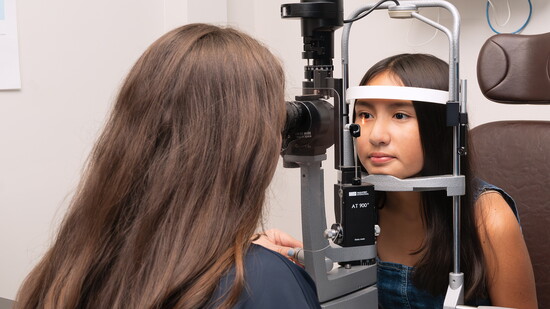Ever since Ashlynn Dennington, O.D., got her first pair of glasses in second grade, she’s been passionate about helping kids see the world more clearly. She still remembers the wonder of spotting individual leaves on trees for the first time—an experience that inspired her path into optometry.
Today, Dr. Dennington leads the team at Texas State Optical Fair Oaks, where she cares for patients of all ages. With myopia, or nearsightedness, now affecting more than a third of children, she offers insight into what parents should watch for—and how to help protect their child’s long-term vision.
(Responses edited for length and clarity.)
tsofairoaks.com | 210-361-0006 | 9091 Fair Oaks Pkwy., Ste. 306, Fair Oaks Ranch
What is myopia?
Myopia is when we are able to see things up close without correction, but things far away are blurry. When the eye is too long, the retina is stretched thin, and the lens focuses light at a point in front of the retina, rather than on the retina itself.
The condition is also progressive because the eye doesn’t reach maturity until our early 20s. As the eye grows in the wrong shape, the retina is stretched thinner and thinner, and the prescription power needed to correct the error increases. Once in adulthood, the stretched retina is at increased risk for conditions like retinal holes and detachments, glaucoma, cataracts, and myopic maculopathy, which can lead to irreversible vision loss.
Early detection and treatment of myopia are critical because we can reduce the risk of our children facing sight-threatening conditions later in life.
When does myopia usually begin presenting in children? What are some warning signs?
Myopia can start in children as young as 6 years old, but it most commonly shows up between 9 and 11 years of age. Having a parent who is myopic gives the child a 33% chance of also being nearsighted, and if both parents are myopic, that jumps to a 50% chance of the child inheriting the trait.
Early warning signs can be squinting, frequent eye rubbing, and moving closer to see the TV or the board at school.
What treatments are available?
Traditional treatments like regular glasses and contact lenses help improve the child's vision, but they don’t help slow the progression of myopia.
To do that, I recommend soft multifocal contacts like Mi-Sight 1-Day lenses. These lenses are the only FDA-approved treatment, and they’ve been proven to slow the progression of myopia when worn correctly by 50%. Plus, they don’t show the same regression at the conclusion of treatment as other treatment options do.
Although LASIK helps correct vision, it does not change the shape of the eye. I had refractive surgery in my early 20s, so I don’t need glasses, but I still have the same risk of having retinal problems as I did before the procedure. Unfortunately, LASIK is not a fix-all.
As a parent, it can be scary when my child faces a medical challenge. What encouragement do you have for parents?
The good news is that we can do something! Problems that can arise in adulthood seem far off for our littles, but childhood and the chance to make a difference fly by in the blink of an eye. Before we know it, our kids will be adults too, possibly facing the risk of losing vision. As a parent myself, the best thing we can do is protect them now while they are still growing.
Fortunately, the best treatment is something most parents are already familiar with: daily disposable soft contact lenses! We are here to help both our parents and patients through this process, so you and your child never have to do it alone.
“The good news is that we can do something! Early detection and treatment of myopia is critical because we can reduce the risk of our children facing sight-threatening conditions later in life.”
